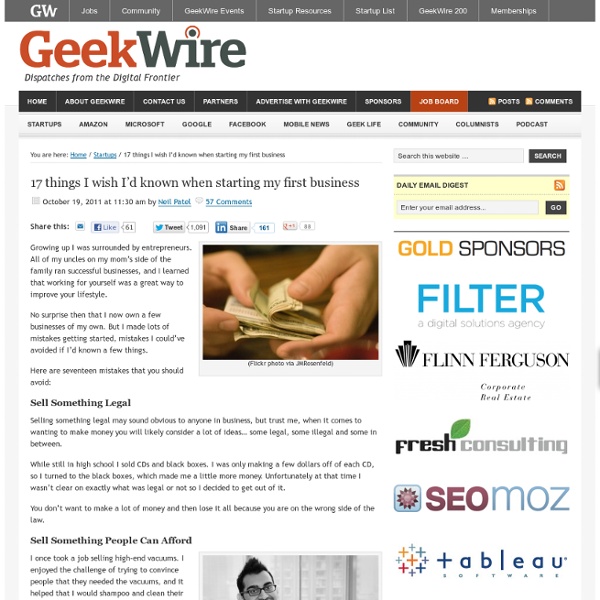The Anatomy of a Perfect Landing Page - Formstack - StumbleUpon
Placement and Content 7. Keep It Above the Fold The space a visitor sees without having to scroll is where the most important parts of the webpage should be. 8. Optimize a landing page for conversion over time. 9. Implementing motivational speeches, videos of user testimonials, and product images into a home page can have a positive impact on viewers, as well as give shoppers an extra push to look further into a product. Bellroy uses great imagery and videos on many of their pages. 10. Links connecting the user to a bunch of other sites or pages will distract them and have a negative impact on conversions. This landing page is designed well, but look at all those header links getting in the way of the message!
:zenhabits
7 Tactics for Open Innovation
The last decade has seen the rise of collaboration as a by-word for innovation success. This is now often referred to as ‘open innovation’ which we define as sharing the risks and rewards of innovation with others. This may sound simple enough and yet in our experience many large organisations struggle with implementing it as open innovation is it can be highly counter-cultural and disruptive. 1. Most people feel pretty comfortable with the idea of spreading the risks of innovation with others, however more interesting and difficult is how we collectively share the rewards. 2. There are several good recent studies about what motives people to participate in collaborative projects (e.g. 3. Whilst open innovation is ultimately about creating new value better, cheaper and faster, don’t mistake this for getting something for nothing. 4. 5. 6. Too many open innovation processes shut down opportunities too quickly based on qualitative criteria. 7. Summary
How Disregarding Design Limits The Power Of Content - Smashing Magazine
Advertisement It appears to be a reader’s market. More written content is freely available than ever before, accessible in just about every format you could imagine. As soon as I ask that question, several others quickly follow: Is content so flexible? These questions didn’t randomly pop into my head one day. I decided to see for myself by examining several pieces of content and comparing how they look and function in a variety of incarnations: the printed page, the Web and eReaders. A Very Brief History of Content and Design Long ago, when we humans first began writing things down, there wasn’t a clear difference between pictures and words. In order to properly document the wealth and splendor of their kings, Sumerian scribes had to repeatedly etch up to hundreds of animal pictograms onto clay tablets. On the left, an example of logographic writing. Sometimes words are enough. Even Basic Formatting Carries Meaning What you’re looking at above is a recipe for cookies. 1. 2. 3. But Wait! 1.
ecommerce et ergonomie 2 vidéos
Guillaume Gronier en pleine action A l’occasion du salon VAD à Lille, j’avais pu organiser deux conférences sur l’ergonomie avec la collaboration du FLUPA. Pour ceux qui les auraient manquées, voici ces deux présentations en téléchargement. >> Comment concevoir un site Web facilement utilisable ? Pour faire face au marché de l’e-Commerce de plus en plus concurrentiel, disposer d’un site Web facilement utilisable constitue désormais un enjeu stratégique majeur pour les entreprises. Par Guillaume Gronier, Ergonome, Centre de Recherche Public Henri Tudor, président de FLUPA (la section franco-luxembourgeoise de l’Usability Professionals’ Association). >> Innovation + Mobilité + Ergonomie = les clés du ROI Le nombre d’applications mobiles disponibles sur les plateformes de téléchargement ne cesse d’augmenter… Dans le même temps, 2011 est annoncée comme étant l’année du site mobile… Et votre business dans tout ça ? La réponse n’est pas si simple. Alors que faire ?
How to Prepare to Launch Your Start-up
John Bradberry was fascinated by the idea of how someone may prepare to start a company. Bradberry, himself an entrepreneur and venture capitalist, has worked for two decades as a consultant to small business owners, and he found himself attracted to the story of one of his clients, Decision One Mortgage founder JC Faulkner. “I wanted to understand why it worked so well, how did he bring the pieces of the puzzle together, and how does that apply to start-ups of other types,” Bradberry says. For answers, he went first to academic research on the subject, and then thought back on his own experience as an entrepreneur. In his book 6 Secrets of Startup Success, Bradberry puts forward five steps that he says will help a person prepare to start a company. Here are Bradberry’s five steps, along with words of advice from entrepreneurs who have learned the value of personal preparation. Step 1: Clarify your reasons and your goals. He launched Renter’s Warehouse in 2006.



